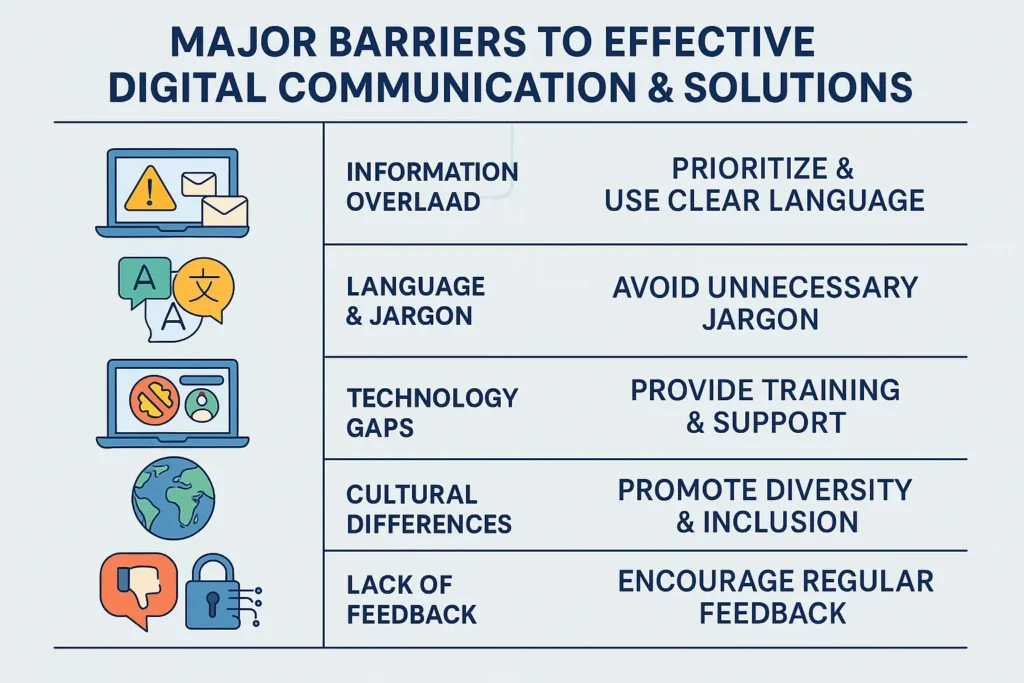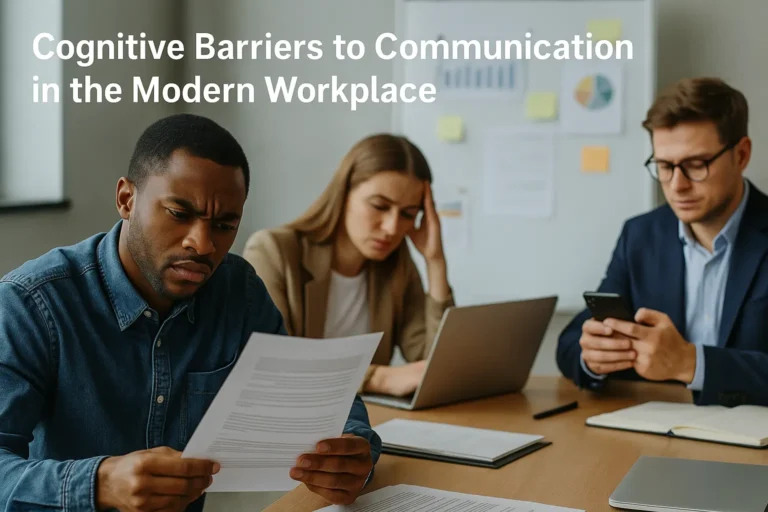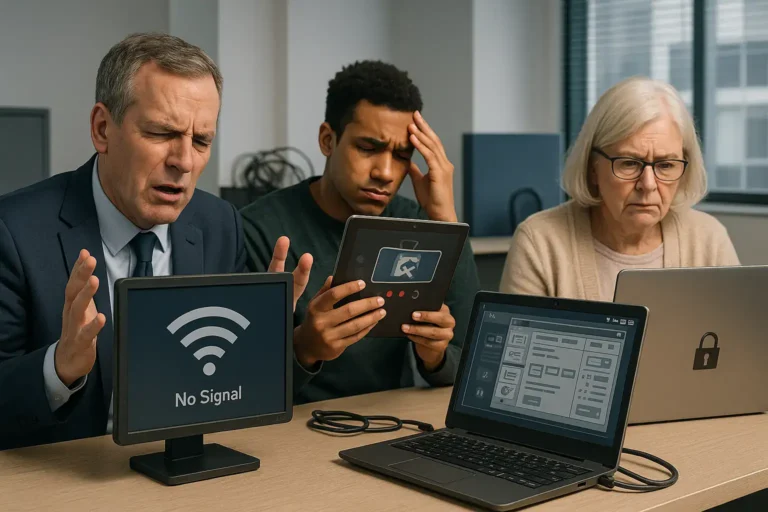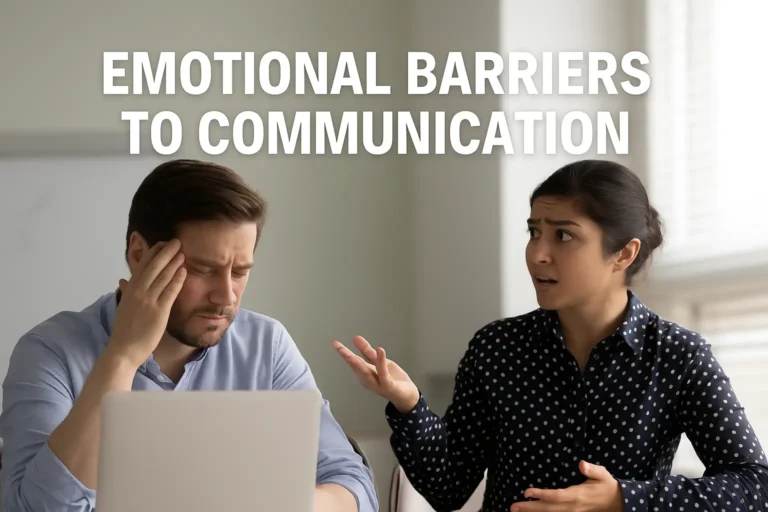Barriers to Digital Communication
Barriers to digital communication affect nearly every workplace, team, and organization in our technology-driven world. Whether you’re using email, instant messaging, web conferencing, or social media, these barriers can disrupt conversations, slow down information sharing, and cause misunderstandings. Understanding what causes barriers to digital communication and knowing how to overcome them is essential for anyone who wants to improve teamwork, boost productivity, and build stronger professional relationships.
What is Digital Communication and Why Does it Matter?
Digital communication is the exchange of information through electronic channels, including email, instant messaging, social media, web conferencing, and collaborative tools. Unlike traditional face-to-face conversations, data communication relies on devices, internet access, and software to deliver knowledge from one person or group to another.
Every organization—no matter its size—depends on effective communication to make decisions, solve problems, and manage teams. Clear messaging can improve health care, strengthen management, increase motivation, and boost confidence in any workforce. When information doesn’t flow smoothly, mistakes happen, productivity drops, and frustration rises.
Key Concepts:
- Digital health: Using technology to support health care communication, including telehealth and electronic health records.
- Communication channel: The route or tool used to share a message (e.g., email, video call, chat).
- Nonverbal communication: Cues like posture, facial expression, and gesture that add meaning beyond words.
- Paralanguage: The tone, pitch, and pacing that affect how spoken words are understood.
Main Barriers to Digital Communication in the Workplace

Information Overload
With the rise of email, instant messaging, and social media, workers face more data than ever before. Too much information can make it hard to focus, prioritize, and respond to important messages.
Example: A health care professional receives dozens of notifications from multiple collaboration tools and electronic health record systems daily. Critical updates may be buried, leading to missed deadlines or errors in patient care.
Solution:
- Prioritize urgent messages and use clear subject lines.
- Limit unnecessary notifications from software and apps.
- Encourage scheduled check-ins rather than constant interruptions.
Digital Literacy and Technology Gaps
Not everyone has the same level of comfort with digital tools or software. Some employees may find new platforms confusing, while others pick them up quickly. This gap affects information flow and overall organization performance.
Solution:
- Offer regular digital literacy and technology training.
- Choose user-friendly collaboration tools.
- Assign digital mentors or “tech buddies” to support new users.
Language and Jargon
Language differences can cause misunderstanding in both written and spoken messages. Even within the same language, jargon or professional slang creates confusion. For instance, in health human resources, terms like “capacity building” or “systematic review” may be clear to experts but unclear to newcomers.
Solution:
- Use plain language and avoid unnecessary jargon.
- Explain technical terms when needed.
- Confirm understanding with quick feedback or follow-up questions.
Nonverbal Communication and Body Language
Digital channels often miss the subtle cues we rely on for full understanding—facial expressions, posture, and gestures. Misinterpreted tone in an email or instant message can cause unnecessary tension or negative feelings.
Solution:
- Use video conferencing for important discussions.
- Add context with emojis, punctuation, or clarifying statements.
- When possible, read messages aloud to catch unintended tone.
Cultural Differences and Social Norms
An organization’s workforce may span multiple countries and cultures, each with its own social norms, language habits, and communication styles. What’s polite or clear in one culture might seem blunt or confusing in another.
Example: In some cultures, direct feedback is welcome. In others, it may be considered rude.
Solution:
- Offer cross-cultural training.
- Encourage empathy and respect for different perspectives.
- Adapt your communication strategy to the recipient’s background.
Attention and Motivation
Digital platforms are full of distractions—from pop-up notifications to the lure of social media. Maintaining attention during a web conference or while reading a long email is tough. Motivation to respond or act may drop, especially when working remotely or across time zones.
Solution:
- Keep messages brief, relevant, and engaging.
- Use visuals like infographics or charts to hold interest.
- Set clear expectations and deadlines for responses.
Privacy, Security, and Trust
Concerns about privacy and risk can block open communication, especially when sensitive health, financial, or organizational data is involved. Employees may worry about who can access their messages or how their information is being used.
Solution:
- Choose secure communication channels with end-to-end encryption.
- Share your organization’s privacy policies and best practices.
- Offer training on risk management, phishing, and safe data handling.
Time Zones and Remote Work Challenges
Global teams often work across multiple time zones, making real-time conversation difficult. Delayed responses can slow down decision-making or leave important questions unanswered.
Solution:
- Use asynchronous tools like project boards or team wikis.
- Schedule regular check-ins that fit different time zones.
- Communicate deadlines and availability clearly.
Feedback Loops and Confirmation
Without face-to-face interaction, it’s harder to know if a message was received and understood. Lack of feedback can lead to confusion, wasted effort, or mistakes.
Solution:
- Encourage two-way communication—ask for confirmation, questions, or feedback.
- Use read receipts or follow-up reminders for important messages.
- Summarize key points and action items at the end of each conversation.
Accessibility and Inclusion
True digital communication works for everyone, including people with disabilities. Accessibility barriers can prevent some team members from participating fully—think of unreadable text, lack of captions, or incompatible software.
Solution:
- Follow accessibility guidelines (such as WCAG).
- Offer alternative text for images, captions for videos, and screen-reader-friendly documents.
- Test your communication tools with people of varying abilities.
How to Build Better Digital Communication in Your Organization
- Choose the right channel: Match your message to the communication channel (email for formal updates, instant messaging for quick questions, video for sensitive topics).
- Encourage feedback: Build a culture where people feel safe to ask questions, share ideas, and voice concerns.
- Provide digital health and privacy training: Teach best practices for data privacy, risk, and cyber hygiene.
- Prioritize empathy and clarity: Remember that emotion and attitude shape understanding. Use simple words, be specific, and consider your audience’s perspective.
- Keep messages concise: Avoid information overload—stick to the point and highlight key actions.
- Monitor and evaluate: Regularly assess your communication strategy and adjust based on feedback and changing needs.
The Impact of Digital Communication on Health and Economy
Digital communication isn’t just about business. It also plays a huge role in health care and the global economy.
- Digital health tools improve access to preventive healthcare, telehealth, and remote monitoring.
- Electronic health records streamline information sharing but require strong data security.
- Collaboration tools support teamwork in health systems, education, and business.
A systematic review of digital health interventions shows that effective communication boosts patient outcomes, staff satisfaction, and resource management.
Conclusion
Clear digital communication is more important than ever—whether you’re managing health human resources, leading a remote team, or supporting customers across the globe. Barriers such as language, information overload, technology gaps, and privacy risks can disrupt the flow of conversation, but with awareness and the right strategies, these hurdles can be overcome.
Remember, effective digital communication is about more than just sending a message. It means understanding your audience, choosing the best communication channel, and valuing feedback and inclusion. Keep messages concise, adapt to your team’s needs, and create a culture of empathy and respect.




